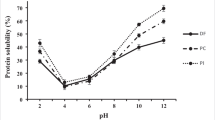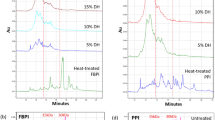Abstract
The effect of seed phytate content (regular and low) on the composition (protein and mineral content), protein quality [in vitro protein digestibility-corrected amino acid score (IVPDCAAS)], iron bioavailability, and functionality (solubility, oil/water holding capacity, foaming capacity and stability, and emulsion stability) of pea flours and extracted protein isolates was investigated. There was 37–45% less phytate in the flours of the low-phytate varieties compared to the regular varieties and approximately 39% less for the isolates. Upon extraction of protein, phytate increased over threefold, but for the mineral ions, this was selective in that Fe2+ ions increased more than threefold, while Ca2+ content halved. The phytate content did not influence the IVPDCAAS of the flours or isolates. The functional properties of the isolates and flours were largely similar between the low and regular phytate varieties. For each variety, iron was more bioavailable in the flours (10.5–22.0 ng ferritin/mg protein) than in the isolates (2.9–16.5 ng/mg). The low-phytate flours (20.6 ng/mg) had overall higher iron bioavailability than the regular phytate pea flours (10.7 ng/mg). For the isolates, this trend was not significant, possibly due to high intra-variety variation and the limited number of samples; however, the mean iron bioavailability value of the three low-phytate isolates was three times greater than that of the two regular phytate isolates. In conclusion, protein isolates extracted from low-phytate varieties did not show deleterious or positive impacts on the functional characteristics or protein quality; more evidence is required for iron bioavailability.
Similar content being viewed by others
References
Cheryan M, Rackis JJ (1980) Phytic acid interactions in food systems. C R C Crit Rev Food Sci Nutr 13:297–335. https://doi.org/10.1080/10408398009527293
Patterson CA, Curran J, Der T (2017) Effect of processing on antinutrient compounds in pulses. Cereal Chem 94:2–10. https://doi.org/10.1094/CCHEM-05-16-0144-FI
Stone AK, Karalash A, Tyler RT et al (2015) Functional attributes of pea protein isolates prepared using different extraction methods and cultivars. Food Res Int. https://doi.org/10.1016/j.foodres.2014.11.017
Gharibzahedi SMT, Jafari SM (2017) The importance of minerals in human nutrition: bioavailability, food fortification, processing effects and nanoencapsulation. Trends Food Sci Technol 62:119–132. https://doi.org/10.1016/J.TIFS.2017.02.017
Gemede HF (2014) Potential health benefits and adverse effects associated with phytate in foods. Glob J Med Res 27:45–55
Wang M, Gao H, Wang J et al (2022) Global burden and inequality of iron deficiency: findings from the Global Burden of Disease datasets 1990–2017. Nutr J 21:1–10. https://doi.org/10.1186/S12937-022-00771-3/FIGURES/4
Shi L, Arntfield SD, Nickerson M (2018) Changes in levels of phytic acid, lectins and oxalates during soaking and cooking of Canadian pulses. Food Res Int 107:660–668. https://doi.org/10.1016/j.foodres.2018.02.056
Fredrikson M, Biot P, Alminger ML et al (2001) Production process for high-quality pea-protein isolate with low content of oligosaccharides and phytate. J Agric Food Chem 49:1208–1212. https://doi.org/10.1021/jf000708x
Warkentin TD, Delgerjav O, Arganosa G et al (2012) Development and characterization of low-phytate pea. Crop Sci 52:74–78. https://doi.org/10.2135/cropsci2011.05.0285
Bangar P, Glahn RP, Liu Y et al (2017) Iron bioavailability in field pea seeds: Correlations with iron, phytate, and carotenoids. Crop Sci 57:891–902. https://doi.org/10.2135/CROPSCI2016.08.0682
Liu X, Glahn RP, Arganosa GC, Warkentin TD (2015) Iron Bioavailability in Low Phytate Pea. Crop Sci 55:320–330. https://doi.org/10.2135/cropsci2014.06.0412
Warkentin T, Kolba N, Tako E (2020) Low phytate peas (Pisum sativum L.) improve iron status, gut microbiome, and brush border membrane functionality in vivo (gallus gallus). Nutrients 12:1–18. https://doi.org/10.3390/nu12092563
Boye JI, Aksay S, Roufik S et al (2010) Comparison of the functional properties of pea, chickpea and lentil protein concentrates processed using ultrafiltration and isoelectric precipitation techniques. Food Res Int 43:537–546. https://doi.org/10.1016/J.FOODRES.2009.07.021
AOAC (2005) Official methods of analysis, 16th ed. Association of official analytical chemists, Washington D.C.
Nosworthy MG, Medina G, Franczyk AJ et al (2018) Effect of processing on the in vitro and in vivo protein quality of beans (Phaseolus vulgaris and Vicia Faba). Nutrients 10:671. https://doi.org/10.3390/nu10060671
FAO (1991) Protein quality evaluation: report of the joint FAO/WHO expert consultation. Italy, Rome
Tinus T, Damour M, Van Riel V, Sopade PA (2012) Particle size-starch-protein digestibility relationships in cowpea (Vigna unguiculata). J Food Eng 113:254–264. https://doi.org/10.1016/j.jfoodeng.2012.05.041
Glahn RP (2022) The Caco-2 cell bioassay for measurement of food iron bioavailability. J Vis Exp. https://doi.org/10.3791/63859
Lindsay DL, Jha AB, Arganosa G et al (2021) Agronomic performance in low phytic acid field peas. Plants 10:1589. https://doi.org/10.3390/plants10081589
Nosworthy MG, Huang S, Franczyk A et al (2021) Effect of genotype, year, and location on the proximate composition and in vitro protein quality of select pea cultivars. ACS Food Sci Technol 1:1670–1676. https://doi.org/10.1021/ACSFOODSCITECH.1C00186
Maharjan P, Penny J, Partington DL, Panozzo JF (2019) Genotype and environment effects on the chemical composition and rheological properties of field peas. J Sci Food Agric 99:5409–5416. https://doi.org/10.1002/jsfa.9801
Hall C, Hillen C, Robinson JG (2017) Composition, nutritional value, and health benefits of pulses. Cereal Chem 94:11–31
Shevkani K, Singh N, Kaur A, Rana JC (2015) Structural and functional characterization of kidney bean and field pea protein isolates: a comparative study. Food Hydrocoll 43:679–689. https://doi.org/10.1016/j.foodhyd.2014.07.024
Lam ACY, Can Karaca A, Tyler RT, Nickerson MT (2018) Pea protein isolates: Structure, extraction, and functionality. Food Rev Int 34:126–147
Hídvégi M, Lásztity R (2002) Phytic acid content of cereals and legumes and interaction with proteins. Period Polytech Chem Eng 46:59–64
Carnovale E, Lugaro E, Lombardi-Boccia G (1988) Phytic acid in faba bean and pea: effect on protein availability. Cereal Chem 65:114–117
de Rham O, Jost T (1979) Phytate-protein interactions in soybean extracts and low-phytate soy protein products. J Food Sci 44:596–600. https://doi.org/10.1111/j.1365-2621.1979.tb03844.x
Dai F, Wang J, Zhang S et al (2007) Genotypic and environmental variation in phytic acid content and its relation to protein content and malt quality in barley. Food Chem 105:606–611. https://doi.org/10.1016/j.foodchem.2007.04.019
Taherian AR, Mondor M, Labranche J et al (2011) Comparative study of functional properties of commercial and membrane processed yellow pea protein isolates. Food Res Int 44:2505–2514. https://doi.org/10.1016/j.foodres.2011.01.030
Ali F, Ippersiel D, Lamarche F, Mondor M (2010) Characterization of low-phytate soy protein isolates produced by membrane technologies. Innov Food Sci Emerg Technol 11:162–168. https://doi.org/10.1016/j.ifset.2009.08.004
Karaca AC, Low N, Nickerson M (2011) Emulsifying properties of chickpea, faba bean, lentil and pea proteins produced by isoelectric precipitation and salt extraction. Food Res Int 44:2742–2750. https://doi.org/10.1016/j.foodres.2011.06.012
Setia R, Dai Z, Nickerson MT et al (2019) Impacts of short-term germination on the chemical compositions, technological characteristics and nutritional quality of yellow pea and faba bean flours. Food Res Int 122:263–272. https://doi.org/10.1016/J.FOODRES.2019.04.021
Fernández-Quintela A, Macarulla MT, Del Barrio AS, Martínez JA (1997) Composition and functional properties of protein isolates obtained from commercial legumes grown in northern Spain. Plant Foods Hum Nutr 51:331–341. https://doi.org/10.1023/A:1007936930354
Lam ACY, Warkentin TD, Tyler RT, Nickerson MT (2017) Physicochemical and functional properties of protein isolates obtained from several pea cultivars. Cereal Chem 94:89–97. https://doi.org/10.1094/CCHEM-04-16-0097-FI
Chitra U, Vimala V, Singh U, Geervani P (1995) Variability in phytic acid content and protein digestibility of grain legumes. Plant Foods Hum Nutr 47:163–172
de la Rosa-Millán J, Orona-Padilla JL, Flores-Moreno VM, Serna-Saldívar SO (2018) Physicochemical, functional andATR-FTIR molecular analysis of protein extracts derived from starchy pulses. Int J Food Sci Technol 53:1414–1424. https://doi.org/10.1111/ijfs.13719
Pedrosa MM, Varela A, Domínguez-Timón F, Tovar CA, Moreno HM, Borderías AJ, Díaz MT (2020) Comparison of bioactive compounds content and techno-functional properties of pea and bean flours and their protein isolates. Plant Foods Hum Nutr 75:642–650. https://doi.org/10.1007/s11130-020-00866-4
Shi D, House JD, Wanasundara JPD, Nickerson MT (2022) Comparative evaluation of the nutritional value of faba bean flours and protein isolates with major legumes in the market. Cereal Chem 99:1013–1029. https://doi.org/10.1002/cche.10575
Kiosseoglou V, Paraskevopoulou A, Poojary MM (2021) Functional and physicochemical properties of pulse proteins. Pulse Foods Process Qual Nutraceutical Appl. https://doi.org/10.1016/B978-0-12-818184-3.00006-4
Liu LH, Hung TV, Bennett L (2008) Extraction and characterization of chickpea (Cicer arietinum) albumin and globulin. J Food Sci. https://doi.org/10.1111/J.1750-3841.2008.00773.X
Petry N, Egli I, Campion B, Nielsen E, Hurrell R (2013) Genetic reduction of phytate in common bean (Phaseolus vulgaris L.) seeds increases iron absorption in young women. J Nutr 143:1219–1224. https://doi.org/10.3945/jn.113.175067
Luo YW, Xie WH, Min-Xu LFX (2012) Effects of phytase and polyphenol oxidase treatments on in vitro iron bioavailability in faba bean (Vicia faba L.). CYTA: J Food 10:165–171. https://doi.org/10.1080/19476337.2011.631222
Moore KL, Rodríguez-Ramiro I, Jones ER, Jones EJ, Rodríguez-Celma J, Halsey K, Domoney C, Shewry PR, Fairweather-Tait S, Balk J (2018) The stage of seed development influences iron bioavailability in pea (Pisum sativum L.). Sci Reports. https://doi.org/10.1038/s41598-018-25130-3
Davidsson L, Dimitriou T, Walczyk T, Hurrell RF (2001) Iron absorption from experimental infant formulas based on pea (Pisum sativum)-protein isolate: the effect of phytic acid and ascorbic acid. Br J Nutr 85:59–63. https://doi.org/10.1079/BJN2000232
Lynch SR, Dassenko SA, Cook JD, Juillerat MA, Hurrell RF (1994) Inhibitory effect of a soybean-protein–related moiety on iron absorption in humans. Am J Clin Nutr 60:567–572. https://doi.org/10.1093/AJCN/60.4.567
Campion B, Glahn RP, Tava A, Perrone D, Doria E, Sparvoli F, Cecotti R, Dani V, Nielsen E (2013) Genetic reduction of antinutrients in common bean (Phaseolus vulgaris L.) seed, increases nutrients and in vitro iron bioavailability without depressing main agronomic traits. F Crop Res 141:27–37. https://doi.org/10.1016/j.fcr.2012.10.015
Funding
Funding to support this research was provided by the Saskatchewan Agriculture Development Fund.
Author information
Authors and Affiliations
Corresponding author
Ethics declarations
Conflict of interest
The authors have no competing interests to declare that are relevant to the content of this article.
Compliance with ethics Requirements
This article does not contain any studies with animals or human participants.
Additional information
Publisher's Note
Springer Nature remains neutral with regard to jurisdictional claims in published maps and institutional affiliations.
Supplementary Information
Below is the link to the electronic supplementary material.
Rights and permissions
Springer Nature or its licensor (e.g. a society or other partner) holds exclusive rights to this article under a publishing agreement with the author(s) or other rightsholder(s); author self-archiving of the accepted manuscript version of this article is solely governed by the terms of such publishing agreement and applicable law.
About this article
Cite this article
Chigwedere, C.M., Stone, A., Konieczny, D. et al. Examination of the functional properties, protein quality, and iron bioavailability of low-phytate pea protein ingredients. Eur Food Res Technol 249, 1517–1529 (2023). https://doi.org/10.1007/s00217-023-04232-x
Received:
Revised:
Accepted:
Published:
Issue Date:
DOI: https://doi.org/10.1007/s00217-023-04232-x




